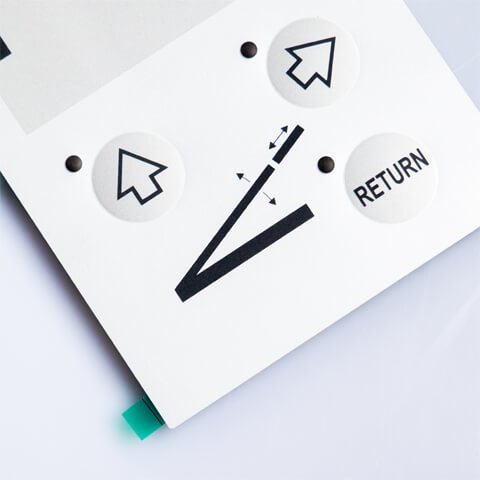Contact
Write to Us And We Would Be Happy to Advise You.
Do you have any questions, or would you like to speak directly with a representative?
By hqt
Most device switch panels available on the market today come with membrane switch panel automotive with rubber or silicone gaskets. It shapes like dome-shape caps turned upside down.

The design of the membrane switch panel automotive is a cover that mounts on a vertical plastic rod with a cap at the bottom, located directly above the three-layer membrane. When the user presses the key to the stop, the rod first descends to the top layer of the membrane.
This closes the circuit of contacts, as a result of which the key activates. The corresponding signal transmits to the device.
This way it only works when fully pressed:
The travel characteristics, level of resistance, and tactile feedback from working with such keys depend on the shape and thickness of the cap use. But the most important feature is that the key works only when pressed all the way.
Key travel length
Membrane switch panel automotive characterize by “full travel”, meaning the key presses down 3.5-4.0 mm before stopping. The elastic membrane layer then returns it to its original position. In some cases, the key stroke can be only 2.5 mm.
Sound Membrane switches are the quietest available on the market. There are no rigid elements in their design that could touch each other and make a knock. Rubber and silicone pads hide the sounds of the keys.
Most standard gasket-cap membrane switch panel automotive have a lifespan of 1 million clicks. However, the use of superior materials allows some manufacturers to push this to 10 million clicks. Regardless of their initial performance, some keycaps lose elasticity over time, while others become too sensitive to pressure.
This can be due to membrane switch panel automotive contamination, excessive stress on rubber/silicone gaskets, imperfections in performance, and even ultraviolet radiation (from rubber “vulcanizes” it).
As a result, when typing on the same switch panel, you have to press different keys with different strengths. Even if it has a duty cycle of “10 million keystrokes”, already in the first year of use there may be a noticeable difference in the operation of individual keys.
Triggering force
The factory actuation force range is quite wide – from 25 grams to 150. Most membrane switches fall in the range of 60-80 grams.
Most capped membrane switch panel automotive are not tactile in architecture, and give the user a fairly “soft” feedback when use.
Damping is the whole point of their design. If desired, they can be “brought” to a certain level of tactility. They will never be able to compare with the sonorous and pronounced knock of scissor or mechanical keys.
It is important to distinguish between ‘dome’ membrane switch panel automotive and ‘flat-panel’ switches. The latter do not have any rounded gasket cap (such keys are often found, for example, on microwave oven control panels), and their travel minimized.
True, flat-panel switches are sometimes found on specialized device switch panels – portable models for traveling – or, say, in industrial versions.
This is a separate small class of membrane switch panels with rubber switch caps. From a mechanical point of view, the design of the switch can completely repeat the traditional membrane only the electronics in this case consists of only one layer.
The “top” of the cap is made of a special rubber that conducts electric current. When the key presses all the way, such a switch immediately closes the circuit of contacts – and the key works.
Such switch panels are relatively rare, not least because their cost is significantly higher than the cost of traditional membrane switch panels.
At the same time, one of the main advantages of membrane switch panel automotive models with electrically conductive rubber is that they are quite easy to repair. It is enough to clean or replace the rubber gasket and the conductive layer.
By comparison, a conventional membrane switch panel requires manufacturing and assembly in the cleanest possible conditions, and disassembling and repairing (or cleaning) such a switch panel is generally not a good idea – and not always effective.
This is another small class in the membrane switch panel automotive panel family, and was singled out on the basis that such switch panels widely uses for laptop and other portable switch panel equipment. The switch structure has rubber dome-shaped gaskets.
As a rule, a standard three-layer membrane is responsible for the electronics of a switch panel with scissor switches. Shorter key travel and less actuation force make this a popular solution for laptops and standalone portable switch panels.
Key travel length.
Scissor membrane switch panel automotive are not “full stroke”; their typical stroke length is 1.0–2.5 mm, in contrast to the 2.5–4.0 mm of classic membrane switch panels. While working with such a switch panel, it is almost impossible not to squeeze all its keys to the stop with each press.

The factory actuation force range is quite wide, starting at 65 grams (gram-force) and going up to 100. Most scissor membrane switches fall in the 65-85 grams range.
Membrane switch panel automotive come with low and high tactile.
At the moment of operation, a click is heard, but due to the tactile design, there is usually no subsequent knock.
The click at the moment of operation is barely distinguishable, and there is often no subsequent key knock – all this is due to the tactile design.
Most membrane switch panel automotive guarantee a duty cycle of 50 million clicks. They are quite easy to clean, unlike the membrane ones with domed caps, while they clog very slowly – this is due to the overall compactness and “density” of the design.
Triggering force
Here, the possible range of indicators is quite wide and starts from 45 grams, and ends with no less than 350 grams! That being said, most mechanical switch panels fall into the 45-65 gram category.
Do you have any questions, or would you like to speak directly with a representative?